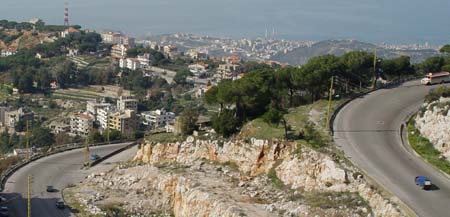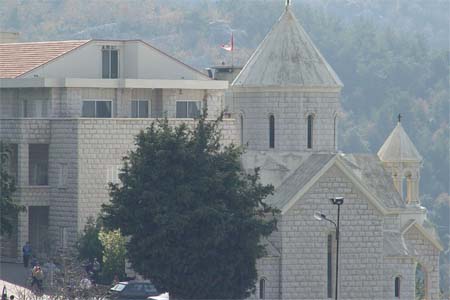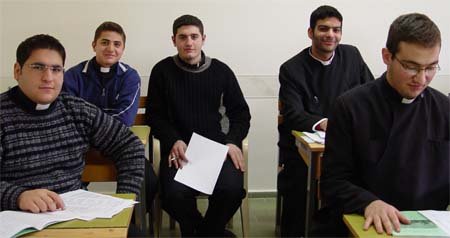Here is one the views from the seminary, the two smokestacks on the distant horizon (just to the right of centre) belong to a coal fired electricity generator at sea level, on the shores of the Mediterranean sea.
Bickfaya means “stone house” in Syriac, and the seminary is a good match for the town, built, for the most part, from hewn native stone. Pictured here, from front to back, the seminary Chapel dedicated to Mary Mother of God and the summer residence of the Catholicos — the monks of the seminary live on the main floor. Hidden from view the seminary building itself: classrooms, halls, and student living quarters in a relatively plain (from the outside) modern building. Click here for the seminary website.
The morning bell is ringing as we arrive, and the students (there are nearly 40 of them — secondary and collegiate) are lined up in the downstairs hallway for opening prayers and the singing of the seminary’s anthem (written by Archbishop Torgom Koushagian, in late 1920’s.) We proceed to my classroom where all 15 of my students (10 deacons, 4 subdeacons, and one “scribe” — 4th, 3rd and 1st years of college, respectively) stand waiting for me to enter. After a brief introduction by Fr. Krikor (photo in an earlier post, below), the fun begins. The students are first rate, their English skills, quite good — very bright, polite and highly disciplined. Do I ever have my work cut out for me!
Pictured here, Subdeacons Shant, Mihran, Alex, and Deacons Varoujean and Kevork (George).
The ten deacons in the group will become eligible for ordination to the priesthood, Deus Volente, at the end of the school year; but the “big decision” must be made first — one that will delay ordinations for a year or more.
In the Orthodox tradition, there are two categories of priest: married and celibate. And these seminarians must choose one path or the other before ordination to the priesthood — marriage after ordination is out of the question. In most of the Eastern Christian traditions (including Byzantine Catholic) married clergy generally become parish priests, while the celibate usually enter a monastic brotherhood and are associated more with the international mission of their church. (In the Armenian tradition only celibate monks can become prelates: high ranking members of the clergy, bishops, archbishops and Catholicos.)
It’s a good system for the Armenian Church, in that it acknowledges differences in vocations, and doesn’t force the married men to compromise family life with the endless round of travel and meetings that generally characterizes the higher ranking offices of the church. I ask Fr Krikor if he hopes that most of the deacons will choose celibacy. He answers, “If I want to help the Catholicosate [i.e. the international Church] I would say, yes; but if I want to help the dioceses [local communities in need of parish priests] I would say, no.” So it seems that helping each seminarian choose the direction that suits him best is also the best way forward for the church. “We really work with them over many years to help them find their way.”
Here I am in Bickfaya. Behind me, the “foothills” leading to the towering mountains of Lebanon — one, Al Qurnat as Sawda, near Tripoli reaches 3360 metres (11,000 feet) in altitude. (Photo: Fr. Moses)













